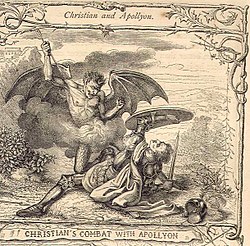Abaddon
| Light iron-age reading The Bible |
| Gabbin' with God |
| Analysis |
| Woo |
| Figures |
Abaddon (meaning "destruction") can refer to two things, an alternate term for the underworld in Jewish mythology[1] or the name of an angel who "leads an army of locusts" during Armageddon.[notes 1]
Judaism
In the case of the Hebrew Bible it indicates that the Jewish conception of the underworld has changed over time, because when, say, the Book of Job was written, which contains the vast majority of references to Abaddon in the Tanakh, the popular understanding of the underworld was that it was simply the land of the dead, Judaism is included in this. The modern conception of Hell would only come about due to the influence of Zoroastrianism on the Jewish religion, when Cyrus the Great allowed the Jews to return to Jerusalem after the long Babylonian exile![]() that resulted from when Nebuchadnezzar
that resulted from when Nebuchadnezzar![]() conquered the Kingdom of Judah.
conquered the Kingdom of Judah.![]() [2] Interestingly the concept of the existence of Abaddon in the first place indicates the ancient Jews believed in more than one underworld, given the references to going to either Sheol (the land of the dead), or Abaddon, the "land of destruction."[1]
[2] Interestingly the concept of the existence of Abaddon in the first place indicates the ancient Jews believed in more than one underworld, given the references to going to either Sheol (the land of the dead), or Abaddon, the "land of destruction."[1]
Christianity
In Christianity Abaddon is considered to be a single entity, not a place, but specifically some sort of demon or entity associated with the apocalypse. In Revelation 9:11, Abaddon is described as "Destroyer",[3] the angel of the abyss,[3] and as the king of a plague of locusts resembling horses with crowned human faces, women's hair, lions' teeth, wings, iron breast-plates, and a tail with a scorpion's stinger that torments for five months anyone who does not have the seal of God on their foreheads.[4]
Gnosticism
The Gnostics placed an important emphasis on Abaddon, the Gospel of Thomas names him as the devil himself.
Abaddon is given particularly important roles in two sources, a homily entitled "The Enthronement of Abbaton" by pseudo-Timothy of Alexandria, and the Apocalypse of Bartholomew.[5] In the homily by Timothy, Abbaton was first named Muriel, and had been given the task by God of collecting the earth that would be used in the creation of Adam. Upon completion of this task, the angel was appointed as a guardian. Everyone, including the angels, demons, and corporeal entities feared him. Abbaton was promised that any who venerated him in life could be saved. Abaddon is also said to have a prominent role in the Last Judgement, as the one who will take the souls to the Valley of Josaphat.![]() [5] He is described in the Apocalypse of Bartholomew as being present in the Tomb of Jesus at the moment of his resurrection.[6]
[5] He is described in the Apocalypse of Bartholomew as being present in the Tomb of Jesus at the moment of his resurrection.[6]
Protestantism
There's no consensus among Protestants, as should be expected, as to whom Abbadon actually is. Some denominations, like the Methodists, consider him to be an angel of God,[7] whereas the pastor Matthew Henry![]() identified Abaddon as the Antichrist,[8] whereas the Jamieson-Fausset-Brown Commentary (1871) and Henry H. Halley
identified Abaddon as the Antichrist,[8] whereas the Jamieson-Fausset-Brown Commentary (1871) and Henry H. Halley![]() identified the angel as Satan.[9][10]
identified the angel as Satan.[9][10]
Notes
- ↑ How he would get a bunch of mindless insects to become his personal army is beyond current scientific understanding.
References
- ↑ 1.0 1.1 See Job 31:12 for an example.
- ↑ "Syncretism and the Zoroastrian influence on the Jewish religion" — Greenwich Time
- ↑ 3.0 3.1 "Revelation 9:11 NIV – They had as king over them the angel of". Bible Gateway. Retrieved 2014-04-05.
- ↑ "Revelation 9:7-10 NIV – The locusts looked like horses prepared". Bible Gateway. Retrieved 2014-04-03.
- ↑ 5.0 5.1 Atiya, Aziz S. (1991). The Coptic Encyclopedia. New York: Macmillan [u.a.] ISBN 0-02-897025-X.
- ↑ "Gospel Of Bartholomew". Pseudepigrapha.com. Retrieved 2014-04-03.
- ↑ Keck, Leander E. (1998). The New Interpreter's Bible: Hebrews – Revelation (Volume 12) ([Nachdr.] ed.). Nashville, Tenn.: Abingdon Press. ISBN 0687278252.
- ↑ "Archived copy". Archived from the original on 7 June 2015. Retrieved 18 March 2013.
{{cite web}}: Unknown parameter|deadurl=ignored (|url-status=suggested) (help)CS1 maint: archived copy as title (link) - ↑ "Archived copy". Archived from the original on 2 January 2015. Retrieved 20 January 2014.
{{cite web}}: Unknown parameter|deadurl=ignored (|url-status=suggested) (help)CS1 maint: archived copy as title (link) - ↑ Halley (1922) Halley's Bible Handbook with the New International Version, p936.
